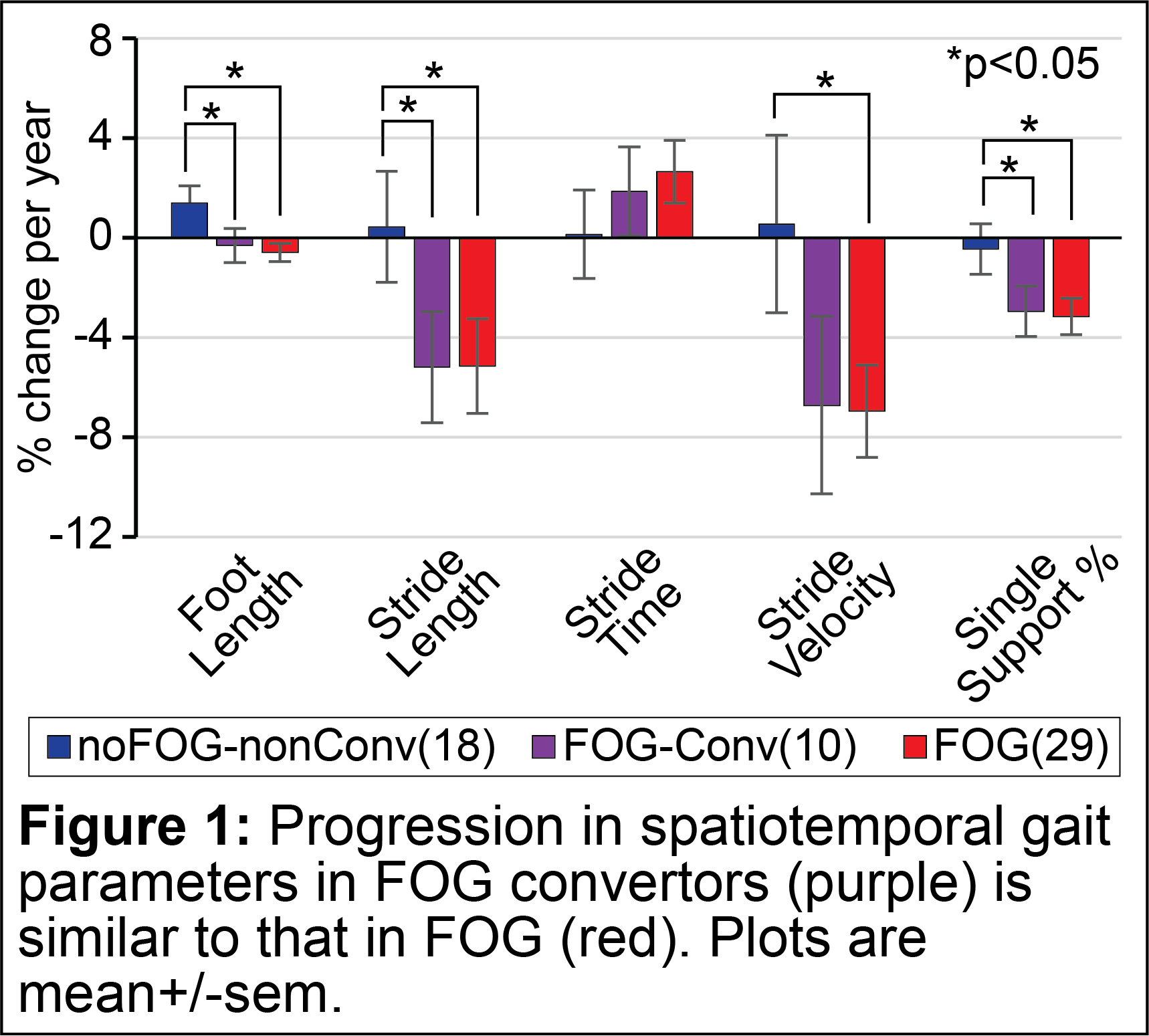Category: Parkinson's Disease: Neurophysiology
Objective: To monitor gait progression in people with Parkinson’s disease (PwPD) who convert from a non-freezing (noFOG) to a freezing of gait (FOG) phenotype.
Background: Development of FOG occurs at different times in the disease process for different people and many motor and non-motor disease features reportedly distinguish people with and without FOG. We previously showed that objective measures of gait decline faster in people with FOG compared to noFOG [1]. It has not been determined whether objective gait decline in people converting from FOG to noFOG is similar to those with FOG or noFOG.
Method: 57 PwPD were enrolled and gait was collected and analyzed using a 20’x4’ gait mat using PKMAS software (Protokinetics). Subjects walked 8 lengths at a comfortable pace every 3-6 months in the levodopa medicated- or ON-state. The slope of change/year (delta) in gait parameters were calculated for subjects completing at least 18-months of follow-up and 3 visits. Statistical analysis was performed using SPSS 28 (IBM).
Results: The enrolled cohort included 28 noFOG and 29 FOG participants, well matched for age (66.5 ± 6.7 years noFOG, 67.2 ± 6.9 years FOG). Over the period of monitoring (average duration 4.2 ± 1.6 years noFOG, 3.6 ± 1.7 years FOG) 10 noFOG participants converted to a FOG phenotype (FOG-Conv), leaving 18 noFOG non-convertors (noFOG-nonConv). FOG-Conv had similar disease duration (5.1±3.7 noFOG-nonConv, 8.3±5.1 FOG-Conv, p=0.106), motor UPDRS scores (10.1±4.2 noFOG-nonConv, 12.8±4.6 FOG-Conv, p=0.148), and MoCA scores (26.1±3.1 noFOG-nonConv, 25.5±3.6 FOG-Conv, p=0.654), compared to noFOG-nonConv. The pattern of decline in objectively measured gait features in 10 FOG-Conv was similar to the 29 FOG participants and not the remaining 18 noFOG participants [Figure 1]. Specifically, a significantly faster rate of decline in foot-length shortening (the length of foot contact with the ground during a step), stride-length shortening, and lesser single support phase percentage was found in both FOGConv and FOG participants compared to noFOG.
Conclusion: FOG-Conv demonstrate a faster decline in objectively quantifiable gait parameters over time that is more consistent with the decline in FOG participants compared to noFOG-nonConv. Early detection of this differential regulation may help predict the future development of FOG.
References: [1] A. Glover, L. Pillai, S. Doerhoff, T. Virmani, Differential Gait Decline in Parkinson’s Disease Enhances Discrimination of Gait Freezers from Non-Freezers, J Parkinsons Dis 10(4) (2020) 1657-1673.
To cite this abstract in AMA style:
T. Virmani, A. Glover, L. Pillai. Gait declines faster over time in people with Parkinson’s disease converting to a freezing of gait phenotype [abstract]. Mov Disord. 2022; 37 (suppl 2). https://www.mdsabstracts.org/abstract/gait-declines-faster-over-time-in-people-with-parkinsons-disease-converting-to-a-freezing-of-gait-phenotype/. Accessed December 4, 2025.« Back to 2022 International Congress
MDS Abstracts - https://www.mdsabstracts.org/abstract/gait-declines-faster-over-time-in-people-with-parkinsons-disease-converting-to-a-freezing-of-gait-phenotype/

